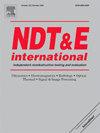On the selection of distance functions and signal processing techniques for guided wave-based damage identification through a likelihood-free Bayesian framework
IF 4.5
2区 材料科学
Q1 MATERIALS SCIENCE, CHARACTERIZATION & TESTING
引用次数: 0
Abstract
Guided wave (GW)-based structural health monitoring (SHM) has been widely used for damage detection in mechanical, civil and aerospace structures. Bayesian method has been integrated with GW-based approaches to enhance the reliability of defect identification and quantify associated uncertainties. Recently, Approximate Bayesian computation (ABC) has attracted increasing attention as a more general and straightforward alternative in Bayesian damage detection frameworks. ABC performs Bayesian inference through a defined distance function to directly assess the similarity between simulated and measured GW signals, eliminating the need to assume an explicit likelihood function to represent the unknown uncertainty distributions inherent in the data generation process. While extensive studies have been conducted to refine ABC sampling algorithms to improve computational efficacy and effectiveness, the effects of different distance functions and signal processing techniques of GW on the performance of ABC have not been reported. This study proposes an advanced ABC framework for damage identification using GW signals. An advanced ABC algorithm based on nested sampling (ABC-NS) is employed to enhance sampling efficiency. The Spectral finite element (SFE) method for numerical GW simulation is utilised to reduce the computational demand in Bayesian inference. A comprehensive performance assessment of the proposed ABC framework is conducted using experimentally measured GW signals from beam-like structures. The focus is directed to the effects of different combinations of signal processing techniques and distance functions on the damage identification results, convergence efficiency, and the degrees of quantified uncertainties. Based on the results, the damage identification accuracy along with the ability of uncertainty quantification are illustrated using the proposed ABC framework. Recommendations are also provided for the selection of the distance functions and signal processing techniques. Finally, the findings of this research offer insights into further development and improvement of likelihood-free Bayesian framework for the applications in GW based SHM.
基于无似然贝叶斯框架的导波损伤识别中距离函数的选择及信号处理技术研究
基于导波的结构健康监测已广泛应用于机械、民用和航天结构的损伤检测。贝叶斯方法与基于gw的方法相结合,提高了缺陷识别的可靠性,并量化了相关的不确定性。近年来,近似贝叶斯计算(ABC)作为贝叶斯损伤检测框架中一种更为通用和直接的替代方法而受到越来越多的关注。ABC通过定义的距离函数执行贝叶斯推理,直接评估模拟和测量GW信号之间的相似性,无需假设显式似然函数来表示数据生成过程中固有的未知不确定性分布。虽然已经进行了大量的研究来改进ABC采样算法以提高计算效率和有效性,但GW的不同距离函数和信号处理技术对ABC性能的影响尚未报道。本研究提出了一种利用GW信号进行损伤识别的先进ABC框架。为了提高采样效率,采用了一种基于嵌套采样的ABC算法(ABC- ns)。采用谱有限元(SFE)方法进行GW数值模拟,减少了贝叶斯推理的计算量。利用实验测量的来自束状结构的GW信号,对所提出的ABC框架进行了综合性能评估。重点研究了信号处理技术和距离函数的不同组合对损伤识别结果、收敛效率和量化不确定性程度的影响。结果表明,本文提出的ABC框架具有较好的损伤识别精度和不确定性量化能力。对距离函数和信号处理技术的选择也提出了建议。最后,本研究结果为进一步发展和改进无似然贝叶斯框架在基于GW的SHM中的应用提供了见解。
本文章由计算机程序翻译,如有差异,请以英文原文为准。
求助全文
约1分钟内获得全文
求助全文
来源期刊

Ndt & E International
工程技术-材料科学:表征与测试
CiteScore
7.20
自引率
9.50%
发文量
121
审稿时长
55 days
期刊介绍:
NDT&E international publishes peer-reviewed results of original research and development in all categories of the fields of nondestructive testing and evaluation including ultrasonics, electromagnetics, radiography, optical and thermal methods. In addition to traditional NDE topics, the emerging technology area of inspection of civil structures and materials is also emphasized. The journal publishes original papers on research and development of new inspection techniques and methods, as well as on novel and innovative applications of established methods. Papers on NDE sensors and their applications both for inspection and process control, as well as papers describing novel NDE systems for structural health monitoring and their performance in industrial settings are also considered. Other regular features include international news, new equipment and a calendar of forthcoming worldwide meetings. This journal is listed in Current Contents.
 求助内容:
求助内容: 应助结果提醒方式:
应助结果提醒方式:


